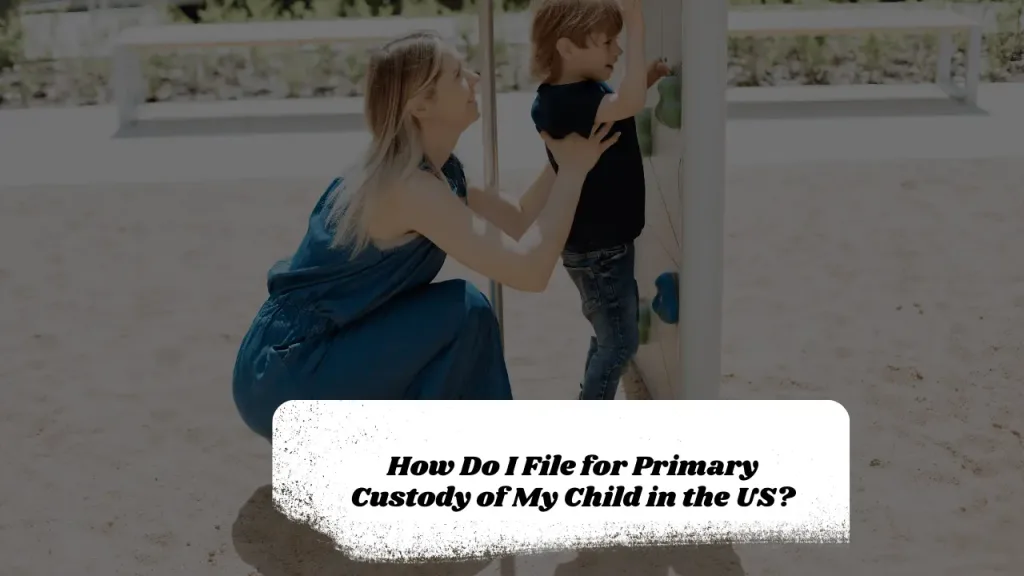How Do I File for Primary Custody of My Child in the US?
When parents separate or divorce, one of the most crucial issues that must be resolved is child custody. Whether you’re trying to secure primary custody of your child or clarify visitation rights, it’s essential to understand the legal process involved. Custody decisions are made based on what is in the best interest of the child, and parents must follow a specific legal procedure to have their voices heard in court. If you’re wondering how to file for primary custody of your child, this guide provides an outline of the process, important legal considerations, and key statistics to help you learn about your case.
Table of Contents
Custody in the US
In the U.S., child custody decisions are categorized into two main types: Physical Custody and Legal Custody.
- Physical Custody refers to where the child will live. If you are fighting for primary custody, this means you want the child to primarily reside with you, while the other parent may have visitation rights or secondary custody.
- Legal Custody involves the right to make major decisions for the child, including decisions related to education, healthcare, and religion.
In many cases, courts aim to grant joint custody, where both parents share these responsibilities, but primary custody may be awarded to one parent if it is in the child’s best interest.
Step 1: Understand Your State’s Laws
Each state in the U.S. has its own child custody laws and procedures. However, custody decisions are primarily guided by the Uniform Marriage and Divorce Act (UMDA), and all states generally follow the principle of what is in the best interests of the child. Factors considered by courts include:
- The child’s health and safety
- Each parent’s ability to care for the child
- The child’s relationship with both parents
- Any history of abuse or neglect
It’s essential to familiarize yourself with your state’s specific custody laws, as these can vary significantly.
Step 2: Determine Jurisdiction
In most cases, custody must be filed in the state where the child has lived for the past six months. This is known as the home state rule. If the child has moved to a different state recently, the court in the new state may not have jurisdiction until the child has lived there for at least six months.
Step 3: Fill Out the Necessary Forms
Once you know where to file, you’ll need to fill out the required forms for a custody petition. These can typically be found on your local court’s website. Some forms you may need include:
- Petition for Custody: This is the formal request to the court for primary custody of your child.
- Parenting Plan: This document outlines how you and the other parent will share custody, visitation, and decision-making responsibilities for your child.
Each state’s court system may have slightly different forms, so be sure to consult your state’s family court resources or contact legal assistance if needed.
Related article: What Is an Ex Parte Hearing for Child Custody?

Step 4: File the Custody Petition
After completing the forms, you will file them with your local family court. In most states, you will need to pay a filing fee, which can range from $50 to $350, depending on your jurisdiction. If you are unable to afford the fee, you may be able to request a fee waiver.
Step 5: Serve the Other Parent
Once you file the custody petition, you are required to legally serve the other parent with a copy of the petition. This is done through formal service, which can be performed by a process server, sheriff’s deputy, or other approved individual. Proof of service must be filed with the court to ensure that the other parent has been notified.
Step 6: Mediation and Court Hearing
In many states, courts will require you to attend mediation before proceeding to a custody hearing. Mediation helps parents come to an agreement on custody arrangements without going to trial. However, if mediation fails or the case involves serious issues like abuse, the court will schedule a hearing.
During the hearing, both parents will present their case. You may need to provide evidence such as:
- Witness testimony
- Documents (school records, medical records, etc.)
- Psychological evaluations or reports from child welfare services
The judge will evaluate the situation and make a custody determination based on what is in the child’s best interest.
Step 7: Court Decision and Custody Order
After hearing from both parents, the judge will issue a ruling, which may include:
- Joint Custody: Both parents share legal or physical custody, though one parent may be designated as the primary custodian.
- Sole Custody: One parent is granted primary physical and/or legal custody of the child, while the other parent may receive visitation rights.
If primary custody is granted to you, the court will issue a custody order, outlining the details of the arrangement, including visitation, decision-making responsibilities, and any other terms.
Key Legal Codes and Considerations
While family law is governed by state statutes, federal laws and guidelines can also influence child custody cases. For example:
- The Uniform Child Custody Jurisdiction and Enforcement Act (UCCJEA) helps resolve custody disputes between states.
- The Violence Against Women Act (VAWA) may come into play if domestic violence is involved in the custody case.
Statistics on Child Custody in the U.S.
- According to the U.S. Census Bureau, approximately 80% of custodial parents are mothers.
- A 2021 report by the National Center for State Courts found that joint physical custody arrangements were awarded in about 27% of cases, while sole physical custody was granted in around 54% of cases.
- In cases involving domestic violence, primary custody is more likely to be awarded to the non-abusive parent, with courts placing a higher priority on child safety.
FAQs Filing for Primary Custody of Your Child in the U.S.
How do I know if I qualify for primary custody?
To qualify for primary custody, you must demonstrate that it is in the best interest of the child for the child to live with you. Factors considered by the court include the child’s health and safety, the parent-child relationship, and the ability of each parent to provide care. If one parent is deemed unfit or unable to provide adequate care, the other parent may be granted primary custody.
Can I file for custody without a lawyer?
Yes, you can file for custody without a lawyer, but the process can be complicated. If you choose to represent yourself, it is crucial to understand the custody laws in your state and follow all procedural requirements. Many courts offer resources or guides to help self-represented individuals, but hiring an attorney is often recommended for complex cases.
What is the difference between joint custody and primary custody?
Joint custody means that both parents share physical or legal custody of the child. Primary custody means that the child primarily resides with one parent, and the other parent may have visitation rights. In some cases, primary custody may be combined with joint legal custody, meaning one parent has physical custody, but both share decision-making responsibilities.
How long does the custody process take?
The timeline for custody cases can vary depending on the complexity of the case, whether both parents agree on custody, and the court’s schedule. If there is no dispute, a custody order can be finalized within a few months. However, contested cases with hearings and mediation may take several months or even longer.
Can I modify a custody order later?
Yes, custody orders can be modified if there is a significant change in circumstances, such as a change in the child’s needs, the parent’s living situation, or if one parent is not adhering to the custody arrangement. To request a modification, you must file a motion with the court and prove that the change is in the best interest of the child.
What if my ex is unfit to care for the child?
If you believe your ex is unfit to care for the child due to factors like abuse, neglect, substance abuse, or other concerns, you can present evidence of these issues to the court. The court will prioritize the child’s safety and may award you primary custody if it determines the other parent is unfit.
What happens if my ex violates the custody agreement?
If your ex violates the custody agreement (for example, refusing to allow visitation), you can return to court to enforce the order. The court may modify the custody arrangement or impose penalties to ensure compliance with the agreement.
Are there any statistics on custody outcomes?
Yes. According to the U.S. Census Bureau, around 80% of custodial parents are mothers. Joint custody is awarded in about 27% of cases, while sole physical custody is granted in 54% of cases, depending on factors like the relationship between the child and each parent, the child’s needs, and any history of abuse or neglect.
Can I get primary custody if my child is old enough to choose?
Depending on the state, children over a certain age may have their preferences considered in custody decisions. For example, in some states, children aged 12 or older can express a preference for which parent they would like to live with, though the court will also consider other factors in determining the best interest of the child.
What is the role of mediation in custody cases?
Mediation is often required before a court hearing to help parents reach an agreement on custody. Mediators are neutral third parties who work with both parents to find a solution outside of court. If mediation is unsuccessful, the case will proceed to a hearing where a judge will make a final decision.
Final Thoughts
Filing for primary custody of your child is a serious and complex process. Understanding the legal framework, following the correct procedures, and being prepared with evidence and a solid case will improve your chances of securing a favorable outcome. If you are unsure of any step, consider consulting with a family law attorney to guide you through the process and ensure that your rights—and your child’s well-being—are protected.
About the Author

Sarah Klein, JD, is a former family law attorney with over a decade of courtroom and mediation experience. She has represented clients in divorce, custody cases, adoption, Alimony, and domestic violence cases across multiple U.S. jurisdictions.
At All About Lawyer, Sarah now uses her deep legal background to create easy-to-understand guides that help families navigate the legal system with clarity and confidence.
Every article is based on her real-world legal experience and reviewed to reflect current laws.
Read more about Sarah
